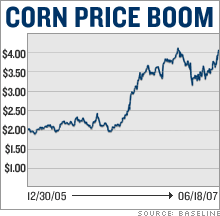Corn and milk: A 1-2 inflation comboCorn and milk prices just keep rising, driven by a soaring demand for ethanol. Got $4 milk? $6 a bushel for corn?NEW YORK (CNNMoney.com) -- The boom in prices for corn, milk, beef and other food products is only getting louder. While it's old news that corn prices have nearly doubled over the last two years - think ethanol - now experts say corn could move sharply higher still, pushing prices up further for milk, beef, pork and a host of other commodities. "If we're just at the beginning of this, we could see underlying [consumer] prices go up another 3 to 5 percent - if things get rolling possibly up to another 10 percent," said Darin Newsom, an analyst at agriculture consultant DTN. "I don't want to scare people, but I certainly see a very solid increase in consumer prices." When corn prices rise, that can make everything from cereal to snack foods to soft drinks more expensive since corn is used by itself or as a sweetener in so many products. Prices for livestock feed also rise, meaning higher costs for producers of steak, pork and chicken. Corn prices are expected to surge another 50 percent in the coming months. Retail milk prices, meanwhile, have already jumped nearly 10 percent since November, but some experts are now predicting another 30 percent increase. That means consumers already wrestling with $3 a gallon gasoline could be paying $4 or more for a gallon of milk. But for milk, at least, the latest surge in prices hasn't been all about corn. Drought conditions in Australia and New Zealand coupled with significantly lower subsidies in European Union countries have helped sap the world's supply of liquid milk and its various byproducts. Meanwhile, as people in China and other booming Asian countries find themselves with more money to spend, they want things like fresh milk and milk products, keeping exporters scrambling to find supplies. "There's just a phenomenal international demand that has moved us to record prices," said Scott Brown, an analyst at the Food and Agricultural Policy Research Institute at the University of Missouri-Columbia. "That is the reason we continue to be strong in our expectations about milk prices over the next few months." Brown sees the price of whole milk, at $3.26 a gallon nationally in May, climbing to about $4.50 a gallon by late summer before eventually falling to around $3.50 later in the fall. Analyst Ken Bailey at Penn State University also sees milk getting close to $4 a gallon. After predicting just last month that milk would top out at $3.35, Bailey now sees prices heading closer to $3.80 and agrees that strong demand from overseas markets is the driving force. Some consumers already have felt the pinch. In New Orleans, which is still recovering from the effects of Hurricane Katrina, the average local price hit $4.09 in May, according to the U.S. Department of Agriculture. In Chicago, the price was $3.86, while Washington D.C. hit $3.72, up 30 cents since January. "Asian countries are screaming, 'Where's our exports?' They want milk powder, whey protein, the stuff in sports bars," Bailey said. "They want all that, and they're just emptying our coffers faster than we can make it." For corn, though, the story is the same. Construction on ethanol plants continues and carmakers are rolling out new flex-fuel vehicles that can run on gasoline or E85, an ethanol-based fuel. Corn, which seemed poised to top out at about $4 a bushel earlier this year, settled at $4.235 Tuesday and is ready to blow past previous estimates, said DTN analyst Newsom, who predicts that corn could hit $6 a bushel before summer's end. "The $6 would certainly seem to be possible by an August-September time frame. It's really hard to pinpoint," he said. "What's really important is what's driving this thing, which is a change in structure that we're seeing from a normal supply-driven market to a demand-driven market." Moreover, Newsom said, prices for various commodities are moving in tandem, another peculiarity of a market where corn is king and biofuel the power behind the throne. Agricultural commodities tend to act independently of each other when it comes to pricing, but the unprecedented demand for corn has sent the prices of other products to unsustainable levels, a trend Newsom said will reverse eventually but not before prices see a dramatic surge. As such, he's forecasting record or near-record prices this year as well for soybeans, wheat, lean hogs and cattle, all of which could be good news for the savvy futures investor as well as farmers but bad news for consumers. Effects of the price increases are likely to be felt far and wide. For example, Wendy's (Charts) lowered earnings guidance Monday and attributed the changes in part to rising costs for various commodities, while Dean Foods Co. (Charts, Fortune 500) also lowered its guidance last week, noting the rising cost of milk. Newsom expects similar news to come from a host of others in the food industry. |
| |||||



